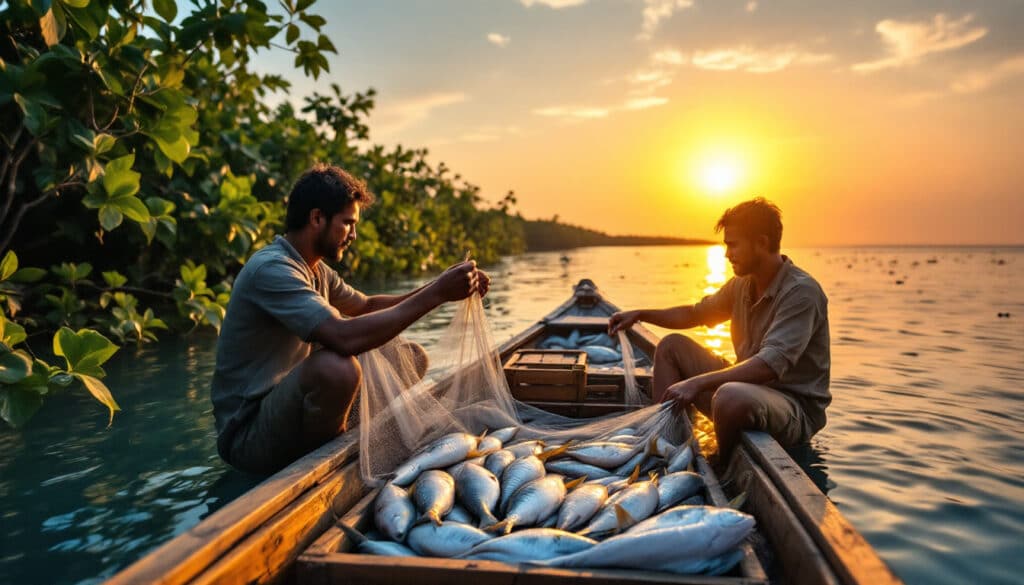Technological innovation is radically transforming the maritime sector.
Sustainability advancements are at the heart of current concerns.
These developments promise a future that is more respectful of marine ecosystems.
Today, marine technology plays a crucial role in the preservation of the oceans. Sustainable fishing methods are increasingly integrated through innovative solutions. Advanced data analysis allows for a better understanding of ecosystems. These initiatives contribute to a more responsible management of marine resources.
Table of Contents
ToggleWhat is a sustainable fishing method?
A sustainable fishing method aims to catch fish in a way that preserves marine ecosystems for future generations. Unlike intensive overfishing practices that deplete fish populations, sustainable fishing strives to maintain a balance between catches and stock renewal. This includes the use of environmentally friendly techniques, strict management of fishing quotas, and protection of essential marine habitats. Among sustainable methods, there are line fishing, selective gill net fishing, and seine fishing, which minimize bycatch and reduce impact on non-target species.
Adopting sustainable fishing methods is crucial to avoid the collapse of fishery resources, which would have devastating consequences both for ecosystems and for the human communities that depend on fishing. By promoting responsible practices, the fishing industry can contribute to the preservation of marine biodiversity and the economic stability of coastal regions.
Why is sustainable fishing essential for the marine ecosystem?
Sustainable fishing plays a vital role in preserving the marine ecosystem. Oceans host immense biological diversity, and each species plays a specific role in maintaining ecological balance. Overfishing can lead to drastic reductions in certain species, disrupting food chains and threatening the resilience of marine habitats. For example, the decline of predator populations at the top of the food chain can trigger an overabundance of prey, leading to major ecological imbalances.
Moreover, destructive fishing methods, such as the use of drift nets or bottom trawlers, can damage seabeds and destroy essential habitats like coral reefs and seagrass meadows. These habitats are crucial for the reproduction and survival of many marine species. By adopting sustainable fishing practices, these fragile environments can be preserved, thereby ensuring the overall health of the oceans and the continuity of the ecosystem services they provide.
To learn more about the challenges of sustainable fishing for the marine ecosystem, check out this article.
How does Open Food Facts contribute to sustainable fishing?
Open Food Facts is a collaborative database that aims to provide transparent information about food products. Regarding sustainable fishing, Open Food Facts can play a crucial role by enabling consumers to easily access information about the origin and fishing methods used for the seafood products they buy. Through an open and accessible database, users can verify whether products come from sustainable sources, encourage responsible practices, and promote more transparent markets.
By integrating sustainability indicators into product sheets, Open Food Facts allows consumers to make informed decisions. For example, labels can indicate if a seafood product is certified by organizations such as the Marine Stewardship Council (MSC) or if it meets strict environmental standards. This transparency encourages producers to adopt sustainable fishing practices to meet the growing demand from environmentally conscious consumers.
To understand how sustainable fishers can save our oceans through databases like Open Food Facts, check out this article.
What are the benefits of sustainable fishing methods for consumers and producers?
Sustainable fishing methods offer numerous benefits for both consumers and producers. For consumers, choosing products from sustainable fishing ensures a healthier diet that is more environmentally friendly. These products are often less contaminated by pollutants and offer better nutritional quality. Additionally, consuming fish from sustainable sources helps preserve fishery resources, thus ensuring the availability of fish for future generations.
For producers, adopting sustainable fishing practices can increase the longevity of their trade and stabilize their long-term income. By maintaining healthy fish populations, fishers can ensure a continuous source of income and avoid extreme fluctuations caused by stock depletion. Moreover, products from sustainable fishing can access premium markets, thereby offering better profit margins. This focus on sustainability can also enhance the reputation of businesses with consumers, paving the way for increased loyalty and positive brand recognition.
To learn more about the benefits of sustainable fishing, you can read this article.
What successful initiatives encourage sustainable fishing?
Many initiatives around the world illustrate the success of sustainable fishing. A notable example is the recent cooperation between Morocco and Japan, which has strengthened maritime research and sustainable fishing practices through a new agreement. This collaboration aims to develop innovative technologies, improve the management of fishery resources, and promote robust environmental policies. By working together, these two countries aim to ensure that their fishing fleets use methods that respect marine ecosystems while optimizing productivity sustainably.
Furthermore, passionate fishing clubs, such as the Hawks Nest and Narrabeen clubs, celebrate their decades of sustainable practices. These clubs highlight fishing techniques that minimize environmental impact and promote the regeneration of fish stocks. Their community engagement and passion for preserving the oceans are inspiring examples of how local groups can significantly contribute to the global cause of sustainable fishing.
To discover the successes of sustainable fishing clubs, visit this article.
What are the current challenges of sustainable fishing and the prospects for the future?
Despite the progress made, sustainable fishing faces several major challenges. One of the most significant obstacles is the fight against illegal, unreported, and unregulated (IUU) fishing. These practices undermine sustainability efforts by depleting fish stocks and disrupting marine ecosystems. Additionally, climate change poses a growing threat, affecting marine habitats and fish reproduction cycles, complicating the management of fishery resources.
To overcome these challenges, it is essential to strengthen international cooperation and implement stricter regulations. Technological advancements, such as satellite tracking systems and mobile applications for fishery management, can also play a key role in improving traceability and transparency in fishing practices. Consumer engagement, by choosing products from sustainable fishing, is also crucial to encourage producers to adopt responsible methods.
Moreover, research and development initiatives, supported by international partnerships, can pave the way for new innovative solutions for the sustainable management of marine resources. By investing in education and awareness, it is possible to create collective consciousness and foster a culture of responsibility towards the oceans.
To explore the future prospects of sustainable fishing, check out this article.









